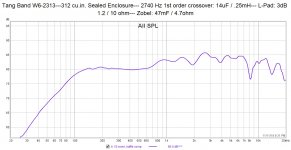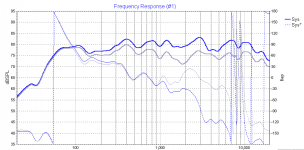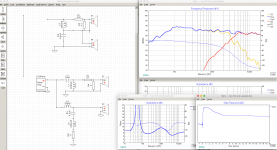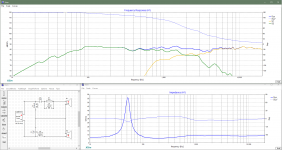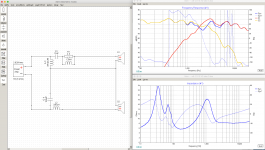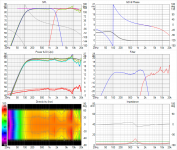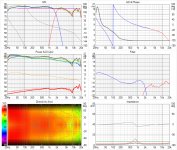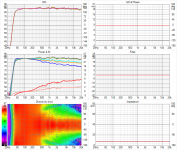Thanks, Pat. I'm running the SB12.3s with a Denon AVR-X4000 pre-outs to a Monoprice Monolith 7 x 200. I don't think I'm getting all 200 watts out of the Monolith as the pre-out voltage is lower than the input sensitivity of the amp. The Monolith HTP-1 16 channel pre-pro is due out on Friday, and I plan to pick one up. My Denon is six years old, so it's about time.
I painted the SB12.3s with General Finishes' "Holiday Red" Milk Paint. It's water-based, so I primed the MDF with Zinzer's oil-based primer.
I painted the SB12.3s with General Finishes' "Holiday Red" Milk Paint. It's water-based, so I primed the MDF with Zinzer's oil-based primer.
New crossover: (I could smell the frustration in your voices)
2740 Hz 1st order crossover: 14uF / .25mH
3dB L-Pad 1.2 / 10 ohm
47mF / 4.7ohm Zobel
This graph is merged near and far field, with a Baffle correction. 1 meter. And, yes, I'll pad down the tweeter some more. Xsim said 3dB would be enough.
I'm curious if the inbound replacement driver will have the same HF rollercoaster that this one has.
Rick
2740 Hz 1st order crossover: 14uF / .25mH
3dB L-Pad 1.2 / 10 ohm
47mF / 4.7ohm Zobel
This graph is merged near and far field, with a Baffle correction. 1 meter. And, yes, I'll pad down the tweeter some more. Xsim said 3dB would be enough.
I'm curious if the inbound replacement driver will have the same HF rollercoaster that this one has.
Rick
Attachments
Last edited:
I've had these breaking in now for about 15-20 hours, at reasonably high levels, and now they sound amazing. I have never heard imaging like this. Yes, the base is light, but more acceptable than I expected.
I'm probably happier with these than any other comparable-sized speaker I've made to date. I'm tempted to try them in a ported enclosure.
Rick
I'm probably happier with these than any other comparable-sized speaker I've made to date. I'm tempted to try them in a ported enclosure.
Rick
The lack of bass mostly comes from the tweeter being too hot still.
Of course, ported will also give you some extension down low, but it will still be too low level compared to the tweeter and will not really show.
You also might consider adding a sealed woofer base to them, so that you can keep the punchiness that sealed designs have over ported ones.
Of course, ported will also give you some extension down low, but it will still be too low level compared to the tweeter and will not really show.
You also might consider adding a sealed woofer base to them, so that you can keep the punchiness that sealed designs have over ported ones.
Your XO compared to mine (in grey).
I got a room node at 200Hz to fill in a little, and with listening to them a bit off axis, I have a nice gradual downslope.
In case you are wondering, my XO is from post 189
TB new line of Coax FR drivers
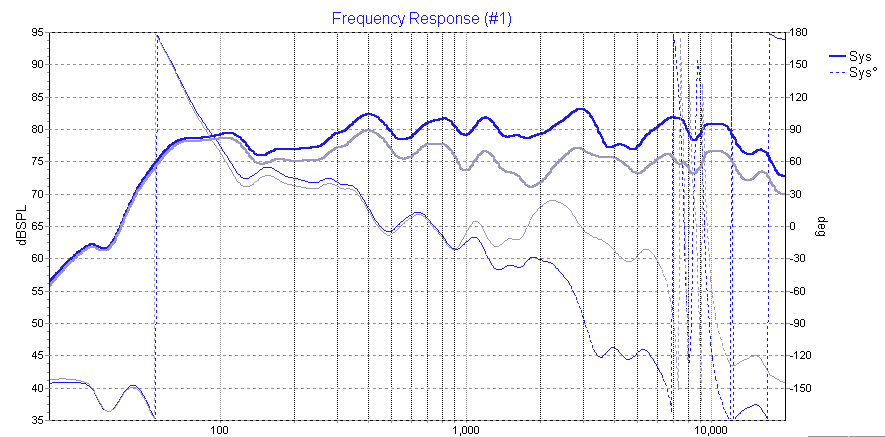
I got a room node at 200Hz to fill in a little, and with listening to them a bit off axis, I have a nice gradual downslope.
In case you are wondering, my XO is from post 189
TB new line of Coax FR drivers
Attachments
Last edited:
I'm curious if the inbound replacement driver will have the same HF rollercoaster that this one has.
Your measurements match roughly mine, so yeah, probably. See here: https://www.diyaudio.com/forums/multi-way/331438-speakers-computer-desk-wall-6.html#post5858183
All coacial tweeters have troubles abovve 6-8kHz. KEF tangerine phase shield is the only really working remedy for that , that I know of.
www.audioexcite.com >> KEF SP1632
I have used and measured several SEAS coaxials, and learned to not worry too much about wiggles! They smooth out off-axis and are not detected by ear. Avoiding comb filtering around xo is much more important.
www.audioexcite.com >> KEF SP1632
I have used and measured several SEAS coaxials, and learned to not worry too much about wiggles! They smooth out off-axis and are not detected by ear. Avoiding comb filtering around xo is much more important.
I just recieved mine a few days ago. here's my observations sofar.
As expected zero bass and what there is comes out distorted even at low levels.. 150 Hz 24 b/oct. active crossover makes miracles. Tweeter sound surprisingly good provided one aplies a higher order cross over frequency, so no 1. order ********, sounds absolutely horrible and strained. With the fully active setup 150 hz and 2500 hz LR 4 th. order and we are talking absolutely high end reproduction. The unevenness on axis i the last octave is not audible, but the advantage of having a point source is. Dispersion is better than expected.
As expected zero bass and what there is comes out distorted even at low levels.. 150 Hz 24 b/oct. active crossover makes miracles. Tweeter sound surprisingly good provided one aplies a higher order cross over frequency, so no 1. order ********, sounds absolutely horrible and strained. With the fully active setup 150 hz and 2500 hz LR 4 th. order and we are talking absolutely high end reproduction. The unevenness on axis i the last octave is not audible, but the advantage of having a point source is. Dispersion is better than expected.
This nice build just appeared on Youtube: Stereo Speaker & Subwoofer System BUILD with Tang Band 8" Coaxial - by SoundBlab
Last edited:
It's been a while, and the drivers have been collecting dust on a shelf, but I am slowly coming around to finish them.
I liked the last XO I made for them, but, I always like to tinker, so I just had to....
Came up with these two.
They look very similar in the end, but one has much lower parts count than the other.
Although that one has a slight dip at 3kHz, so it might dull the music a bit.
I will have to test... coming in the next 6 months, I guess... yep, always staying busy!
So, if someone wants to try, I'll put them down here.
Feel free to comment or give them a shot.
I liked the last XO I made for them, but, I always like to tinker, so I just had to....
Came up with these two.
They look very similar in the end, but one has much lower parts count than the other.
Although that one has a slight dip at 3kHz, so it might dull the music a bit.
I will have to test... coming in the next 6 months, I guess... yep, always staying busy!
So, if someone wants to try, I'll put them down here.
Feel free to comment or give them a shot.
Attachments
Hi Perceval,
Hope you don’t mind my asking a few questions about the TB coaxial drivers.
But first an explanation of why I am now interested in the TB coaxial drivers. AudioScienceReview published a review of the Genelec 8341A monitor, and the measurements are rather impressive. Then I realized that the 8341A is just a W-C-W (woofer-coaxial-woofer) design with (at least) two interesting twists: (1) a shaped front baffle that serves as a shallow wave guide for the coaxial driver, and (2) slot-loading of the woofers, which maybe partially necessitated by the relatively large front baffle/wage guide. I got the feeling that it might not be too difficult to put together a DIY version that at least looks similar to the 8341A and may even measure reasonably well, with the assistance of DSP. A TB coaxial might be a good choice for the DIY version.
Since you have been playing with the TB 6" coaxial, perhaps you can help me by providing your opinions regarding the two versions of the TB coaxial drivers.
1. Which version do you think would be a better choice for this particular application? I am leaning toward the 6" version, as it might be easier to have match the directivity of the cone with that of the tweeter around the crossover frequency. The cone of the 8" version, however, might become too beamy at the crossover frequency. But from the published frequency response curves, it seems that the it might be easier to do the crossover for the 8" version.
2. Do you see any inherent flaws in the TB coaxial drivers that you think could prevent them from providing great results?
3. Some lesser coaxial drivers seem to have an interference dip caused by the not-so-good termination of the cone. See, e.g., the ASR measurements of the Kali IN-8 studio monitor, showing dips in the 8-10 KHz range. The Genelec 8341A monitor, however, does not show that at all, perhaps because of the smooth transition between the cone and the shallow wave guide. Do you see such an interference dip in the frequency response of the TB 6” coaxial driver?
Thanks in advance for your answers.
Kurt
Hope you don’t mind my asking a few questions about the TB coaxial drivers.
But first an explanation of why I am now interested in the TB coaxial drivers. AudioScienceReview published a review of the Genelec 8341A monitor, and the measurements are rather impressive. Then I realized that the 8341A is just a W-C-W (woofer-coaxial-woofer) design with (at least) two interesting twists: (1) a shaped front baffle that serves as a shallow wave guide for the coaxial driver, and (2) slot-loading of the woofers, which maybe partially necessitated by the relatively large front baffle/wage guide. I got the feeling that it might not be too difficult to put together a DIY version that at least looks similar to the 8341A and may even measure reasonably well, with the assistance of DSP. A TB coaxial might be a good choice for the DIY version.
Since you have been playing with the TB 6" coaxial, perhaps you can help me by providing your opinions regarding the two versions of the TB coaxial drivers.
1. Which version do you think would be a better choice for this particular application? I am leaning toward the 6" version, as it might be easier to have match the directivity of the cone with that of the tweeter around the crossover frequency. The cone of the 8" version, however, might become too beamy at the crossover frequency. But from the published frequency response curves, it seems that the it might be easier to do the crossover for the 8" version.
2. Do you see any inherent flaws in the TB coaxial drivers that you think could prevent them from providing great results?
3. Some lesser coaxial drivers seem to have an interference dip caused by the not-so-good termination of the cone. See, e.g., the ASR measurements of the Kali IN-8 studio monitor, showing dips in the 8-10 KHz range. The Genelec 8341A monitor, however, does not show that at all, perhaps because of the smooth transition between the cone and the shallow wave guide. Do you see such an interference dip in the frequency response of the TB 6” coaxial driver?
Thanks in advance for your answers.
Kurt
Sorry for the delay. Been busy.
Between the 6" or the 8".I'd go for the 6".
I believe someone here mentioned it sounded better, and yes, the 8" will start beaming much lower, making it harder to cross over the tweeter.
There are no major flaws, but I've had two little issues.
-There is a dip at 4.5kHz that makes it hard to cross cleanly over the tweeter.
- The speaker tabs plastic mounts are very fragile, and I broke one with only very little force applied. Will need to be glued back later.
The tweeter does the job, but it isn't the cleanest FR I've ever seen. There are some interactions from the cone.
That Genelec monitor uses heavy DSP to cross their drivers, and change the FR according to the user's needs.
Any kind of setup can be made to look good on paper with heavy DSP lifting.
So, if your plans include the use of DSP, then I wouldn't worry too much. It will be easy to make each part of the curves look good and provide a good transition. I'd probably try a Harsch XO if going DSP.
This driver is smooth and clean. I'm sure it can handle a bit of "curve massaging" to make it sound exactly as you need it to be.
And they do physically look good!
Between the 6" or the 8".I'd go for the 6".
I believe someone here mentioned it sounded better, and yes, the 8" will start beaming much lower, making it harder to cross over the tweeter.
There are no major flaws, but I've had two little issues.
-There is a dip at 4.5kHz that makes it hard to cross cleanly over the tweeter.
- The speaker tabs plastic mounts are very fragile, and I broke one with only very little force applied. Will need to be glued back later.
The tweeter does the job, but it isn't the cleanest FR I've ever seen. There are some interactions from the cone.
That Genelec monitor uses heavy DSP to cross their drivers, and change the FR according to the user's needs.
Any kind of setup can be made to look good on paper with heavy DSP lifting.
So, if your plans include the use of DSP, then I wouldn't worry too much. It will be easy to make each part of the curves look good and provide a good transition. I'd probably try a Harsch XO if going DSP.
This driver is smooth and clean. I'm sure it can handle a bit of "curve massaging" to make it sound exactly as you need it to be.
And they do physically look good!
I use the measurement the guy made from his heavy damped sealed 5L box. I don't know if he did smoothing, i just received the FRD and ZMA files and went from there. If you want to give me yours, i can also do a little take on it and see if i can get it smoother.
And it looks as your measurements are not right, as the efficiency is way lower than mine and what the numbers of the official sheets tell you. Are you sure your measurements are done right, and the calibration of your system was set right?
And it looks as your measurements are not right, as the efficiency is way lower than mine and what the numbers of the official sheets tell you. Are you sure your measurements are done right, and the calibration of your system was set right?
Last edited:
Sorry for the delay. Been busy.
Between the 6" or the 8".I'd go for the 6".
I believe someone here mentioned it sounded better, and yes, the 8" will start beaming much lower, making it harder to cross over the tweeter.
There are no major flaws, but I've had two little issues.
-There is a dip at 4.5kHz that makes it hard to cross cleanly over the tweeter.
- The speaker tabs plastic mounts are very fragile, and I broke one with only very little force applied. Will need to be glued back later.
The tweeter does the job, but it isn't the cleanest FR I've ever seen. There are some interactions from the cone.
That Genelec monitor uses heavy DSP to cross their drivers, and change the FR according to the user's needs.
Any kind of setup can be made to look good on paper with heavy DSP lifting.
So, if your plans include the use of DSP, then I wouldn't worry too much. It will be easy to make each part of the curves look good and provide a good transition. I'd probably try a Harsch XO if going DSP.
This driver is smooth and clean. I'm sure it can handle a bit of "curve massaging" to make it sound exactly as you need it to be.
And they do physically look good!
Thanks for the opinions! I think I'll go with the 6" (6.5") driver.
Kurt
...few questions about the TB coaxial drivers...
For info using onni's 0/30/60 directivity in post 93/94 we far from good coverage but also far from any 8341A perfomance, in first visual below EQ mirrors is used to massage a known textbook passband of 100Hz-20kHz and steep linear phase XO region @1822Hz because their DI cross briefly there, in second visual systempass band for PIR is massage to JBL trained listener curve from Toole's book first edition, third visual ASR analyze of 8341A
Attachments
Last edited:
For info using onni's 0/30/60 directivity in post 93/94 we far from good coverage but also far from any 8341A perfomance
Hi BYRTT,
Very interesting figures! From these figures, I can guess your message is that it might be futile to attempt to use the TB 6" coaxial to achieve something that is close to the measurements of the Genelec 8341A. Did I get it right?
What do you think is the "secret sauce" that distinguishes the coaxial used in the 8341A from the TB 6" coaxial? Or is the difference really in how the shallow waveguide of the 8341A helps in taming the interference dips and the associated wild phase swings?
Kurt
- Home
- Loudspeakers
- Multi-Way
- TB new line of Coax FR drivers
